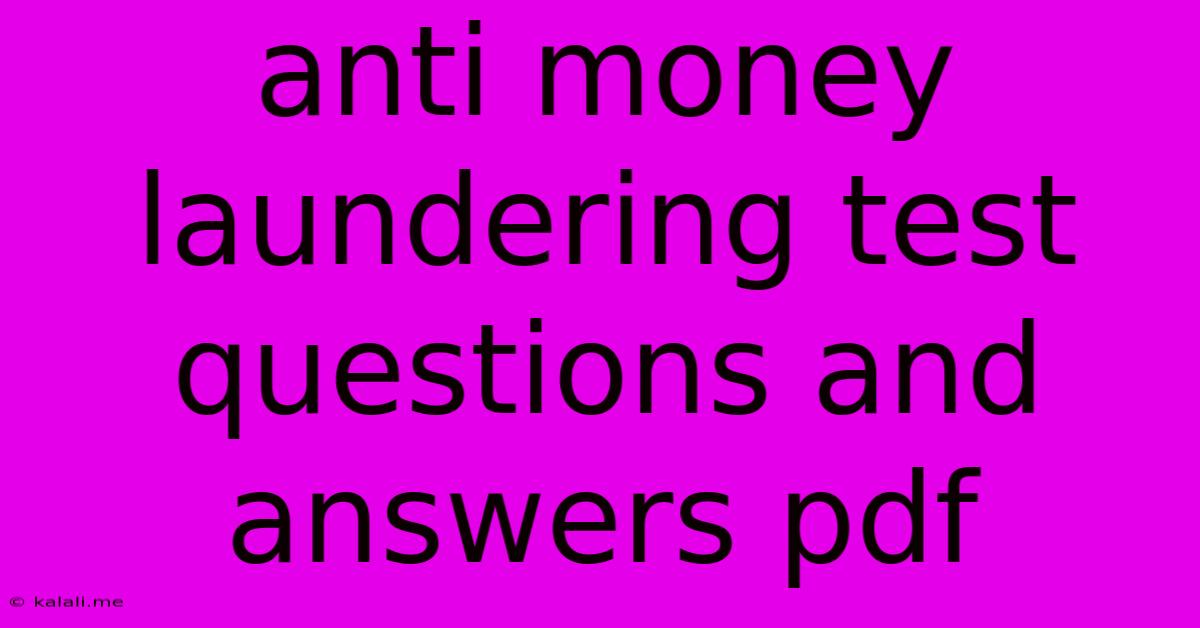Anti Money Laundering Test Questions And Answers Pdf
Kalali
Jun 12, 2025 · 3 min read

Table of Contents
Anti-Money Laundering (AML) Test Questions and Answers
This article provides a comprehensive overview of common Anti-Money Laundering (AML) test questions and answers. Understanding AML compliance is crucial for financial institutions and businesses to prevent illicit financial activities. While this isn't a substitute for professional AML training and certification, it serves as a valuable resource for self-assessment and knowledge reinforcement. Remember to always consult official regulatory guidelines and legal counsel for specific compliance requirements in your jurisdiction.
What is Anti-Money Laundering (AML)?
AML refers to a set of laws, regulations, and procedures designed to prevent criminals from disguising illegally obtained money as legitimate funds. This involves identifying, monitoring, and reporting suspicious financial transactions to the relevant authorities. Key aspects include identifying the beneficial owner of funds, understanding the source of wealth, and maintaining detailed transaction records. Failure to comply with AML regulations can result in severe penalties, including hefty fines and legal repercussions.
Common AML Test Questions and Answers:
Here are some common AML test questions categorized for clarity, followed by concise answers.
I. Know Your Customer (KYC) Procedures:
-
Q1: What is the purpose of KYC procedures?
- A1: KYC procedures aim to identify and verify the identity of customers to prevent money laundering and terrorist financing. This involves collecting and verifying identifying information, such as proof of address, identification documents, and source of funds.
-
Q2: What information is typically collected during KYC due diligence?
- A2: Typically, KYC procedures involve collecting information like full name, date of birth, address, identification document numbers (passport, driver's license), and sometimes employment details and source of funds. The level of due diligence varies depending on the risk assessment of the customer.
-
Q3: What is considered a "Politically Exposed Person" (PEP)?
- A3: A PEP is an individual who holds or has held a prominent public function. This includes government officials, senior executives of state-owned corporations, and others in similar positions. PEPs are subject to heightened scrutiny due to their increased risk of involvement in corruption and money laundering.
II. Suspicious Activity Reporting (SAR):
-
Q4: What is a Suspicious Activity Report (SAR)?
- A4: A SAR is a formal report filed with the relevant financial intelligence unit (FIU) when a financial institution detects a transaction or activity that appears suspicious and potentially related to money laundering or terrorist financing.
-
Q5: What are some red flags that might trigger a SAR?
- A5: Red flags can include unusually large cash transactions, complex or layered transactions, transactions involving known or suspected criminals, or inconsistencies in customer information. Unusual activity patterns and transactions that don't align with a customer's known profile also raise concerns.
-
Q6: What are the consequences of failing to file a SAR when required?
- A6: Failing to file a SAR when there is reasonable suspicion can result in severe penalties, including hefty fines, reputational damage, and even criminal charges.
III. AML Compliance Program:
-
Q7: What are the key components of a comprehensive AML compliance program?
- A7: A robust AML program typically includes a risk assessment, KYC procedures, ongoing customer due diligence, employee training, transaction monitoring, suspicious activity reporting, and independent audits.
-
Q8: Why is employee training crucial for AML compliance?
- A8: Employee training is crucial because it ensures that all staff members understand their roles and responsibilities in preventing money laundering. This includes recognizing red flags, following KYC procedures, and reporting suspicious activity.
-
Q9: How often should an AML compliance program be reviewed and updated?
- A9: An AML compliance program should be reviewed and updated regularly, at least annually, or more frequently if necessary to reflect changes in regulations, risks, or business operations.
This is not an exhaustive list, and the specifics of AML regulations vary across jurisdictions. Always refer to the relevant regulatory guidance for your specific location and industry. Seeking professional advice from qualified AML compliance experts is highly recommended.
Latest Posts
Latest Posts
-
Single Entry Vs Double Entry System
Jun 13, 2025
-
Which Of The Following Is A Rational Number
Jun 13, 2025
-
Which Of The Following Components Converts Ac To Dc
Jun 13, 2025
-
The Middle Letter Of The Alphabet
Jun 13, 2025
-
The Expanded Ends Of A Long Bone Are Called The
Jun 13, 2025
Related Post
Thank you for visiting our website which covers about Anti Money Laundering Test Questions And Answers Pdf . We hope the information provided has been useful to you. Feel free to contact us if you have any questions or need further assistance. See you next time and don't miss to bookmark.